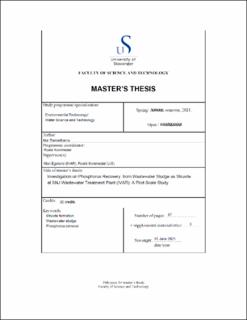| dc.description.abstract | The recovery of phosphorus from wastewater is desirable since it is a limited nutrient and can cause eutrophication in water bodies. This study investigates the potential to recover phosphorus from the sludge generated at SNJ Wastewater Treatment Plant (WWTP). A laboratory experiment and a pilot-scale of continuous operation were performed to test the optimum reactor configuration for struvite recovery. Based on the sludge characteristics, digested sludge has a high potential for struvite recovery. The molar ratio of Mg:P:N in digested sludge was at 0.8:1:21.8, which indicated that all struvite-forming ions present in the digested sludge. Aeration of digested sludge showed that when CO2 was stripped, the pH was increased and induced the dissolved phosphorus removal by struvite formation. The continuous airlift operated at HRT 8 hours, and the reactor could remove dissolved phosphorus from digested sludge to 30 mg/l without magnesium addition and 16 mg/l with magnesium. The removal of dissolved phosphorus and magnesium, along with an increase in pH level, suggested that struvite formation occurred inside the reactor, but it is yet to be confirmed. | |
